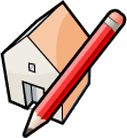Google Sketchup, by far the most popular 3D modeling tool in the known universe, now has a great way to send your Sketchup model to a 3D printer. Simply install the new plugin from CADspan and you’ll be able to generate solid .STL files suitable for submission to most 3D print services and printers.
The plugin provides basic 3D features only, and the resulting .STL file is completely solid. This might be ok for some applications, but probably there will be a lot of wasted print media in thick objects.
The plugin permits you to pull models from Google’s very extensive 3d warehouse and prep it for 3D printing. Basically, this means “water proofing” the model so that no interior-facing surfaces are visible. In other words, you have to make the model completely water-tight so that it can become “solid”. The plugin uses easy visual coloring effects to help you through this potentially tedious process.
Another interesting feature we noticed was that you can not only export your model as .STL, but you can also import .STL as well.
Via Google Sketchup Blog and CADspan



That was an inspiring post,
Nice information about 3d modelling,
Thanks for bringing this up
Hey, that was interesting,
I just dont understand how a 3d printer works!
Thanks
Hi,
How can I print out a Sketchup design with measurements (in mm) next to each line?
Cheers,
TF
Thanks for blogging about our plugin! (and thanks for looking at the plugin as well) Your comment about making the model watertight is a good one. We are tweaking some of the documentation and videos. You don’t actually have to make the model completely watertight, just mostly watertight. CADspan has a very sophisticated adaptive gap fill that is controllable from the plugin. What you have to do is make the model “unambiguous” from a computer’s perspective. In other words, holes and gaps that are large relative to the model size or relative to the detail you want to preserve will create problems. Small holes and gaps will surface. We are trying to set early users up to be successful with their first resurfacings but some people who have tried to make a model completely watertight might be put off by thinking that they still have to chase every hole.
We would love to know what features readers want. We have a lot of great new code as well as ideas. We are not trying to do everything that a service bureau or machine operator can do such as hollowing and offsets, multi-build etc. We are trying to make it easy for a much larger audience to use 3d printing.
Many Thanks
Charles – and the CADspan Team.